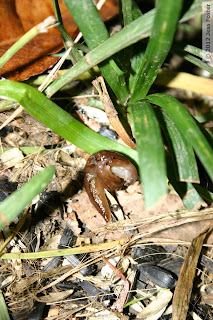Now, a few weeks back I observed a mating couple, and copulation progressed with the usual behavioral characteristics, except that this time there was a new element I hadn't seen before. I've divided the following photos by stages and will provide comments as we go along. If you would like a refresher on the behavior of this species in the precopulatory and copulatory phases, consult these posts as well as the others in the series:
Precopulatory Period - Intro
Type A Courtship
Penial Appendix - Part 1
Sperm Exchange Hypothesis
Type 1 Withdrawal
Couple #33:
1. Courtship
a. After the two slugs investigate each other with their cephalic tentacles (precourtship), they engage in trail-following, where one slug becomes the leader and the other follows, nibbling at the leader's tail and using that sense of touch (by mouth and tentacles) to keep up.
b. Having chosen a mating site, the lead slug turns back and the two slugs begin to circle each other. As they enclose around each other, they mouth one another with their radulae, each slug nibbling the other's body mucus.
2. Copulation
a. After becoming entwined and nibbling each other's body mucus, the slugs extrude their penial appendices.
b. Once the penial appendices have everted to their full extent, the penes emerge explosively...and are just as quickly retracted into the gonopores. In this brief interval, a matter of seconds, between eversion and retraction, sperm is exchanged. Each slug will produce eggs that are then fertilized by this sperm. Then the slug lays the fertilized eggs (ejecting them from the gonopore) and after several days, the tiny baby slugs hatch.
**New feature: As you can see in the photos below, the slug in the foreground (the leader during trail-following and smaller of the two) has a white substance on its right side, at the location of the gonopore. This could either be an indication of an unsuccessful sperm exchange (i.e. the white substance is the sperm mass that should have been transported through the gonopore into the body) or a delayed penis retraction (i.e. the white substance is the penis or penial appendix exposed or bulging beneath the skin). But as the substance appears milky, almost bubbly, I believe the first hypothesis (that it's the sperm mass) is more probable. This is the first time I've observed a potentially unsuccessful sperm exchange.
a. After retracting their penes, the slugs remain entwined for a while, rubbing against each other and nibbling body mucus.
b. They then separate and, in this instance, the larger slug that had been the follower during trail-following stays behind to consume the leftover mucus. If you read my other posts on withdrawal, you'll see that this is not always the case. Sometimes neither eats the mucus.
 |
| You can see the thick cord of mucus between the two slugs, stretching as they separate. |





































No comments:
Post a Comment